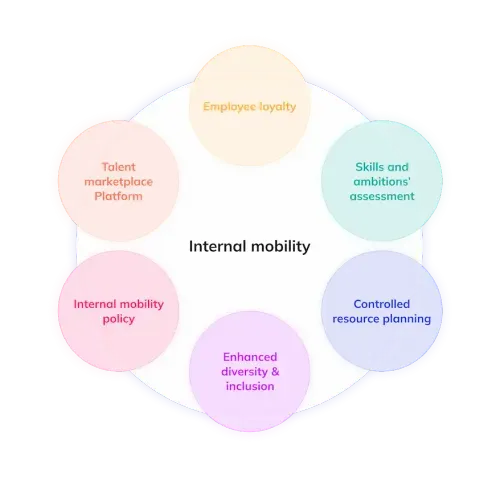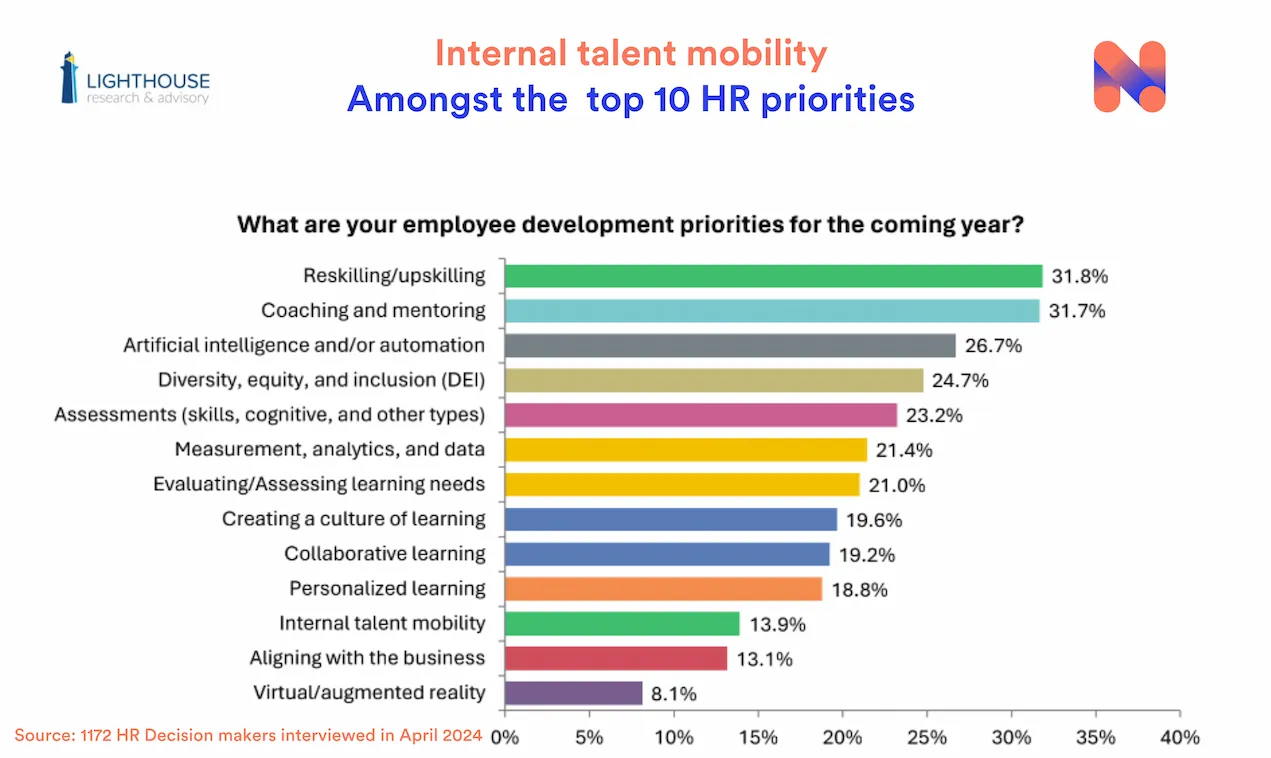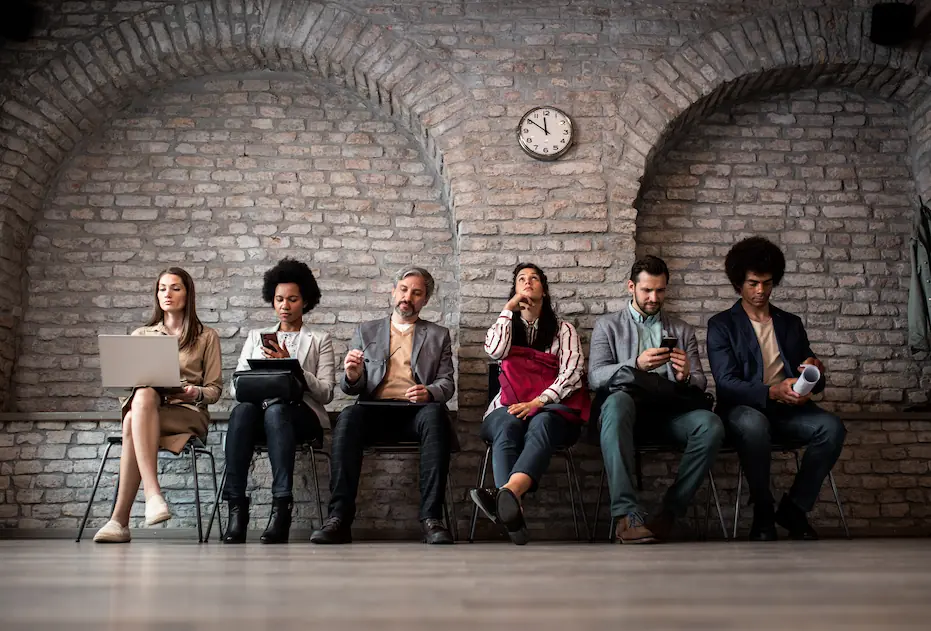The tactical challenge of Internal Mobility
Apec estimates that 18% of executives change jobs internally every year. These movements, which take several forms, are to be distinguished from internal promotions. While internal mobility can be positive, it can sometimes be imposed on the employee, thereby damaging the working relationship.
How can we build an internal mobility policy that allows individual aspirations and collective performance to express themselves?

- How do you define internal mobility?
- Identify the different types of internal mobilities
- Define internal mobility main objectives
- Key success factors for internal recruitment
- Our best practice tips
- The stages of setting in motion the internal trajectories
- Major tools for internal mobility
- A revolution for internal mobility: the Talent Marketplace
- You may also like
Internal mobility is an HR management tool designed to enhance career development and, more generally, to respond to medium-term resource planning. Considered as an immediate response to the need to transform certain professions, it is now a strategic priority for 81% of HR managers.
An internal mobility policy must be adapted to the needs of the organization and the expectations of its employees. As a result, the current challenge for human resources teams is to define the contours of this policy, and to implement it on a day-to-day basis using concrete examples.
Our partner, Lighthouse, surveyed 1,172 decision-makers in April 2024.
The conclusion? Talent mobility in their top 10 priorities (see chart below).

How do you define internal mobility?
Identify the different types of internal mobilities
What are the different types of internal mobility?
We can list 4 types of internal mobility:
- Vertical mobility aims to offer a move to a higher hierarchical level,
- Cross-functional mobility consists of providing access to a different role in a new profession, regardless of hierarchical level
- Horizontal mobility helps to offer similar responsibilities within a similar profession
- Geographical Mobility involves transferring an employee to another site.
The company is becoming more horizontal and, consequently, more focused on participative management. These changes call into question the role of managers, who must adopt a Manager Coach posture. They also bring to the fore the plurality of responsibilities and qualifications, as well as the identification of possible bridges between professions.
In this context, the notion of proximity skills is at the heart of the approach. The challenge is to re-mobilize employees to perceive possible changes in their professions: this is what the“Galaxie de métiers” offers, as presented by Carole Menguy, Head of Innovation, on BFM’s B Smart program.
Define internal mobility main objectives
What is your initial HR diagnosis?
Before defining your objectives, you need to take stock of your internal population in a number of ways. Here are the 3 main ones:
1. Attrition of talents
Attrition is calculated by dividing the number of employees who have left the company over a given period by the number of employees at the start of the period.
- What are the sources of this attrition? Are these employees leaving the company because of disagreements with their managers? For reasons of remuneration? Poor integration? Lack of progression? Poor life balance? ….

2. Efficiency
Efficiency encompasses the notion of performance and the time, means, devoted to the achievement of objectives.
- What is the average level of attainment of EAD objectives? What is the real impact of the development plans put in place?
3. The wage bill
The payroll corresponds to all salaries, bonuses, wages, thirteenth month, ….
- How does this wage bill evolve in relation to sales? How does the weight of managers’ salaries evolve in relation to the average salary?
Benefit from all the advantages of internal mobility
Based on this diagnosis, we need to capitalize on the advantages of developing internal trajectories. What are these assets?
- Retaining high-potential employees is the most obvious reason for adopting this strategy.
- Offering a wide range of career prospects enables employees to plan for the long term.
- Experimenting with different positions and developing your skills skills, as well as feeling valued by your employer, are just some of the advantages of internal mobility.
- Attracting talent.
- Modernizing recruitment levers by promoting internal movements is a good way of enhancing the “career management” aspect of the employer brand.
- Employees who become ambassadors can put the company in the spotlight, which can be very attractive to future candidates.
- Developing employability.
- Adapting skills to a constantly changing world is a key competitive advantage for companies.
- Continuously updating skills to keep pace with the needs of the sectorenables the company to remain agile and therefore competitive.
Key success factors for internal recruitment
The gap between ambition and the reality of internal career paths demonstrates the need to bring together the key players in order to create a real culture. Changing mentalities requires formalizing the advantages and disadvantages of the 2 staffing methods: internal and external recruitment.
76% of people who aspire to a different job look for it outside the company because of a lack of concrete prospects.
This policy is embodied in an “internal mobility charter”.
What is an internal mobility charter?
The internal mobility charter sets out the broad outlines of possible career paths, the roles of each player involved, and the rules and stages to be followed, in a consistent message. This official document sets out the key moments at which employees can discuss this project, and also reassures them about the notion of confidentiality associated with any internal application. Indeed, there remains a perceived risk in applying internally: how will my manager react? Could this have a negative impact on my future development? We offer you a complete study of internal recruitment practices, thanks to the participation of 117 HR decision-makers.
On a more restrictive note: mobility agreements or clauses.
What is a Mobility Agreement?
This agreement is subject to collective bargaining, i.e. with employee representative bodies. Consequently, it sets out the terms and conditions under which a professional, geographical or other type of transfer will take place. To be valid, the agreement must be restricted to a specific area, take account of the employee’s personal life, and include compensatory measures such asassistance with training.Our best practice tips
Even today, this HR tool is aimed more at the “talent” population, which in certain respects differs from the process used for the majority of employees. We devote a chapter to this in our “The specificities of talent mobility” page.
Yet, from both a global resource planning and an equity perspective, mobility is a powerful driver of diversity and inclusion.
What questions should be asked to define the internal mobility policy?
Here are some guidelines to formalize your orientations with 8 questions that we ask our partners:
These questions are not exhaustive, and your company’s specific needs must be taken into account. It’s best to be prepared for your employees’ questions. We have dedicated a full page to defining the guidelines of your internal career development strategy.
The internal mobility interview
Depending on the company, this process will be necessary to validate the application. 70% of moves within the company are initiated by employees (Capital 2022 figures). These wishes are formulated in different ways and must be formalized in the employee’s history. So, not only does this moment enable employees to discuss their career aspirations with their employer, it alsoenriches their knowledge of the employee. Depending on the individual, this meeting can be a source of anxiety if the employee expresses a desire to evolve without denigrating his or her current role. For the manager, there is also the question of how to retain the right person and support them with the means at their disposal.
Here is the recipe to make this meeting a success: “Succeed in your mobility interview in 5 acts“.
A structured system to minimize potential risks
What are the risks and reserves?
Changes of assignment can have an impact on 3 dimensions: the transmission of skills, the generation of internal conflicts, and the difficulty of adapting to a new work environment. Let’s take a closer look at these 3 risks and their solutions:
- The transfer of skills : when employees leave their current position, their former position may remain vacant, resulting in a one-off loss of skills. Solutions can be found in succession planning, permanent mentoring, the development of cross-functional skills , the ability to mobilize a resource rapidly in project mode, or to make this movement conditional on the staffing of a new resource.
- Conflicts of interest : internal movements can sometimes create conflicts of interest, especially if the position was coveted by several people. Solutions include making the selection criteria transparent, offering applicants for the position components of the role in their daily lives, and distributing tasks differently.
- Smooth induction : getting to know the company does not necessarily mean that employees will adapt immediately, and this can be minimized by managers and HR teams. Companies are becoming increasingly aware of good onboarding and cross-boarding practices.cross-boarding
“Companies are becoming increasingly aware of good onboarding or cross-boarding practices, which give similar importance to the successful integration of new employees when they change jobs within the company.
This change for the individual will also be facilitated by the quality of their experience within their HR application. For example, the synchronization of this information must be automated, his support and his new objectives centralized.
Paradoxes to overcome
Apart from these risks, the process suffers from several paradoxes:
- Managers are encouraged to promote a variety of career paths, yet when they apply for positions, they are required to have a high level of expertise, which prevents them from landing the role. This limits the scope of managerial initiatives.
- The boundary between, on the one hand, the freedom to create unique pathways and, on the other hand, the organizational priorities decided in the framework of Jobs & Skills Management, affects the desired pathways and requires making compromises.
- There is still a great deal of uncertainty and the good will to build coherent paths often turns into opportunism in the face of circumstances.
The stages of setting in motion the internal trajectories
Forging a culture is an integral part of planning, an activity that is becoming essential for effective management of company investments.
The success of this ambition depends on the wealth of information :
- Their assets and skills
- Visualize the skills keys to the future
- The immediate projects and priorities of the company and its managers
- Access to satellite jobs by proximity
We are convinced that an implementation methodology adapted to the company’s culture is a guarantee of success. Natixis increased internal recruitment in less than 6 months, with total retention to date, based on a formula we describe below. This is the Natixis success story.
- Step 1: Identify and formalize the needs resulting from the Jobs & Skills Management
- Step 2: Gather together all your career development needs and skills .
- Step 3: Manage each of the internal recruitment processes, taking care of replacements and coaching.
- Step 4 : Measure the success of internal recruitments by evaluating performance and development of skills. Then enrich career paths based on the new developments that have taken place.
All of these steps are described in detail in our “Steps to successful internal recruitment” page.
Major tools for internal mobility
- The repository of skills
- The Mapping of skills
- Annual interviews
- Career committees
- Performance reviews and monitoring
- Training programs
A revolution for internal mobility: the Talent Marketplace
As software deployment projects evolve, HR teams have become increasingly aware of its key success factors. Offering users the best possible experience not only contributes to the return on their investment through excellent adoption, but is also a strong lever for engagement. A good experience means bringing all the intelligence together in one place, which finds its legitimacy in a harmonious interaction between the software’s different functionalities. Neobrain’s“talent engagement platform” is used by many companies, including LVMH, Natixis, Safran and SNCF.
Curious about how it works? We’ve devoted a whole page to it: “Internal Talent Marketplace“.
FAQ
- How to choose between external recruitment and internal mobility?
There are several criteria to consider when making a decision about different recruitment methods:
- The skills required: if the position to be filled requires specific skills , it may be more appropriate to recruit externally.
- Cost: internal mobility is generally less expensive than external recruitment. However, you will have to include all the expenses (training, onboarding, etc…)
- Corporate culture: an internal employee is already familiar with the company’s culture and values. It may therefore be easier to train them on the specifics of the new position
- How to measure the impact of internal mobility on employee retention?Several indicators can be taken into account to measure the impact of internal mobility on employee retention:
- Employee retention rate: this involves monitoring the departure rate of employees who have benefited from internal mobility compared to those who have not been involved in internal mobility.
- Employee satisfaction: it is important to measure the satisfaction of employees who have benefited from internal mobility. Indeed, a successful mobility can increase their motivation and their commitment to the company.
- Cost of recruitment: by comparing the costs of external recruitment with those of internal mobility, it is possible to measure the financial impact of internal mobility.
- What are the current trends in internal mobility in companies?In order to meet the transformation needs of their market, the trend is to invest in project-based resource allocation programs. Sage, for example, operates on a Squad basis, which benefits the organization in 3 ways:
- This organization is an opportunity to strengthen knowledge sharing
- This operation mobilizes the skills in a short time.
- Recruiting costs are reduced and talent identification is enhanced
See the Sage use case.
- How to support employees during their transition to a new position?The practice of “cross-boarding” is growing, and it allows employees to be supported during their transition to a new position within the company. This involves organizing an integration period during which the employee will discover his or her new position and work environment, while continuing to work in his or her old position. To make this transition period a success, it is important to set up personalized support for each employee, to communicate regularly with employees to inform them of the progress of their transition and to give them feedback on their work.
Do you still have questions ?
Please feel free to contact us for more information 😃












